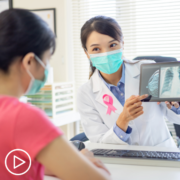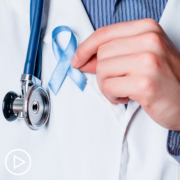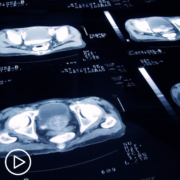Tag Archive for: radiation
Key Questions Patients Should Ask Before Participating in a Breast Cancer Clinical Trial
Key Questions Patients Should Ask Before Participating in a Breast Cancer Clinical Trial from Patient Empowerment Network on Vimeo.
What questions should breast cancer patients ask their healthcare team before entering a clinical trial? Dr. Adrienne Waks shares her advice and key questions that breast cancer patients should ask before participating in a trial.
Dr. Adrienne Waks is the Associate Director of Clinical Research at Dana-Farber Cancer Institute. To learn more about Dr. Waks click, here.
See More from Breast Cancer Clinical Trials 201
Related Resources:

|

|

|
Transcript:
Katherine:
What are some key questions patients should ask their healthcare team about participating in a trial?
Dr. Waks:
Yeah, I think there’s a couple of major ones. What’s the rationale behind this trial? Why do you think it might be better than the standard? What do I stand to gain in terms of effectiveness? Do you think it could be worse than the standard of care, and why or why not? So, basically, trying to capture well, what’s the rationale and the potential benefit of a trial? We’re always doing trials to try to give the patient some sort of benefits, so very reasonable to ask about that. Number two, of course, is what are the extra side effects that could be associated with participation on this trial, and how much do you know about them?
Is this a drug that you’ve used for five years in a different context or is it a pretty new drug and you don’t have a great sense, so number two, what are the side effects potentially associated with participation on the clinical trial? And then the third thing I would say is what is the extra burden on me going to be, not in terms of side effects but in terms of life disruption, time spent and things like that? What are those extra burdens going to be if I participate in a clinical trial will I have to get extra scans, will I have to do extra visits, will I have to get extra biopsies?
You know, there are a number of clinical trials that require biopsies or have optional biopsies at least because in addition to studying a new drug we’re trying to understand in whom does it work and in whom does it not. And so, we want to have biopsies to help us understand that, but a patient should obviously want to be informed about those biopsies.
So, what will the extra on me look like? And then, we always try as investigators in a clinical trial to put in place as best we can some ways to sort of mitigate the burden on patients. Like, well if I have to have a biopsy, can my parking be covered that extra day or what accommodations can be made to try to mitigate some of the disruption or the extra time? So, I would say those are sort of the three or four main things to ask about.
Should Breast Cancer Patients Consider a Clinical Trial?
Should Breast Cancer Patients Consider a Clinical Trial? from Patient Empowerment Network on Vimeo.
Dr. Adrienne Waks, a breast cancer expert, discusses why and when patients should consider participating in a clinical trial.
Dr. Adrienne Waks is the Associate Director of Clinical Research at Dana-Farber Cancer Institute. To learn more about Dr. Waks click, here.
See More from Breast Cancer Clinical Trials 201
Related Resources:

|

|

|
Transcript:
Katherine:
Why should a breast cancer patient consider participating in a clinical trial?
Dr. Waks:
It’s a great question. I always tell patients and, of course, I work at Dana Farber, so we participate and I come to this question with a bias and a huge enormous amount of belief in the importance and the value of clinical research, but I honestly would encourage all patients to encourage clinical trials at all points in their breast cancer care. I think that often patients think that clinical trials are something that your doctor will bring up when you’re scraping the bottom of the barrel in terms of cancer treatment options.
You know, you’ve exhausted everything that’s good and now we’re going to give you treatments that were given to the mice last week or something like that. But that could not be further from the truth. At every stage of breast cancer treatment whether you have a stage I breast cancer or you have a metastatic breast cancer, all of the current standards for how we treat patients and all of the data that we have to tell us you should use those treatments because they’re beneficial, all of those standards and those data come from patients who came before you who participated in clinical trials. Those were not patients who were at the very last stage of their cancer treatment.
They were patients who could have been newly diagnosed with a Stage I breast cancer, newly diagnosed with metastatic breast or something like that. We change the standards of how we treat patients at all stages by running clinical trials.
In breast cancer, we have such effective treatments that it’s virtually unheard of that we would compare something to nothing. There’s almost never a time in breast cancer treatment when it’s ethical to offer nothing as a therapy, so most of our clinical trials are not saying you might get a placebo sugar pill and that’s it. It’s saying either you’ll get Arm A, which is this agent or you’ll get A plus B which is the standard plus something else. So, it’s not like by participating in a clinical trial you’re omitting standard therapy. What we’re generally trying to do is give you standard therapy and something better or replacing a part of standard therapy with something we think is going to do better.
Every time we design and implement a clinical trial, we’re obviously doing so because we hope that we can improve upon the current standard. So, there certainly isn’t a trial for everybody at every stage in their treatment course, and it’s absolutely fine if there’s no trial ongoing that’s the right fit for you, but I think it’s always a good question to ask. You know, is there a trial I should consider here?
Hesitant to Join a Breast Cancer Clinical Trial? What You Should Know.
Hesitant to Join a Breast Cancer Clinical Trial? What You Should Know. from Patient Empowerment Network on Vimeo.
What do breast cancer patients need to know about clinical trials? Breast cancer expert Dr. Adrienne Waks addresses common concerns and misconceptions about trial participation.
Dr. Adrienne Waks is the Associate Director of Clinical Research at Dana-Farber Cancer Institute. To learn more about Dr. Waks click, here.
See More from Breast Cancer Clinical Trials 201
Related Resources:

|

|

|
Transcript:
Katherine:
What would you say to patients who may be hesitant to participate in a trial?
Dr. Waks:
That’s a great question. I think many patients are at first hesitant to participate in a trial, which is natural. You know, there’s already so many overwhelming and scary decisions to be made when it comes to getting a breast cancer diagnosis or any cancer diagnosis that introduce a whole other set of discussions. Instead of variables, it’s found extremely overwhelming and adds another level of what might feel like uncertainty, so I think that’s a completely natural response is to be hesitant and overwhelmed if somebody brings up the clinical trial.
But what I would try to address in terms of patient concerns is number one, I think that patients worry that if they are approached about a clinical trial that means there aren’t other good options available to them which not always, but almost always is actually far from the truth. Usually it’s just because we have a standard, we think it’s pretty good but we’d like to do better than the standard and participating in a clinical trial is how we do that.
So, first I always, of course, assure patients this clinical trial is not like something we’ve never tested before and we know nothing about it, and it’s not because I don’t have other options for you. It’s just because I want to do better than the existing options and often it’s looking at an agent that’s already FDA-approved, but we’re trying to combine it with a different agent or something like that.
So, obviously, number one try to give patients some reassurance about what we already know about the trial agents and also reassure them about the fact that we don’t anticipate the efficacy of their treatment overall would be compromised. Rather we’re trying to improve upon that. So, I think that’s probably the most common concern that I hear from patients, but, of course, as providers it’s our job to understand from that specific patient who’s in front of you what are your particular concerns about clinical trials in general. And are those misconceptions that I can dispel for you, or are they real things that some women on trials do experience in which case we should talk through them and decide if it’s the right fit for you.
It’s almost always true that participating in a clinical trial does come with what I always call a few other hoops to jump through, because when you’re participating in a clinical trial we want to learn from your experience. So, we do want women to complete questionnaires about their side effects or have a second appointment one week later so that we can do an extra side effect check-in or something like that. You know, do an EKG that they wouldn’t otherwise need. So, there can be and often are some additional logistical or scheduling components that come with participation in the trial.
Again, we would want a patient to voice how that might or might not fit into her life and be very up front about what could be expected in terms of additional asks which can be extremely minimal or sometimes more disruptive depending on the trials. So, obviously, we just need to have a conversation about that.
Why Should Breast Cancer Patients Feel Empowered to Speak Up About Their Care?
Why Should Breast Cancer Patients Feel Empowered to Speak Up About Their Care? from Patient Empowerment Network on Vimeo.
Why is it important for breast cancer patients to speak up and have a voice in their care? Breast cancer expert Dr. Adrienne Waks shares her perspective encouraging patients to ask questions and understand their care.
Dr. Adrienne Waks is the Associate Director of Clinical Research at Dana-Farber Cancer Institute. To learn more about Dr. Waks click, here.
See More from Thrive Breast Cancer
Related Resources:

|

|

|
Transcript:
Katherine:
Why should patients feel empowered to speak up and ask questions?
Dr. Waks:
Well, I think for all sorts of different reasons. I think in breast cancer there are times when there’s a very clear right answer and right path forward and then a variety of other options that are clearly not recommended, not standard of care inadvisable, dangerous whatever, so there’s plenty of circumstances where that’s the case. But there’s also lots of circumstances, probably the majority of decisions that a patient has to make over the course of her or his breast cancer treatment plan and a variety of circumstances where there’s actually a number of different reasonable paths forward.
Again, I think that’s the physicians or the nurse practitioner, the infusion nurse, whatever healthcare practitioner is helping to guide the patient through that particular decision, it’s our role to help lay out those options. Ultimately, we will always look to the patient for the most important final decision, so in order to make that decision, a patient needs to ask questions and help us understand where is she or he coming from, and what are their values and what are their competing interests, competing priorities outside of their breast cancer diagnosis, what is the most important outcome, a thing they want to maximize most, a thing they don’t really care about.
We’ll never be able to bring that perspective to the table. We always look to the patient to do that.
And so, they’re only get there by asking questions. Obviously, we’re going to try our best to anticipate all of the questions and lay out the options as comprehensively as we can, but there will always be things we can’t anticipate and things that are important to the patient that we just simply could never know about. So, we understand, appreciate, expect, and hope that a patient will ask questions and even more so that their accompanying family member or friend will do the same.
What Role Do Breast Cancer Patients Play in Care and Treatment Decisions?
What Role Do Breast Cancer Patients Play in Care and Treatment Decisions? from Patient Empowerment Network on Vimeo.
What is shared decision-making? Breast cancer expert Dr. Adrienne Waks outlines the shared decision-making process and explains how patients can play an active role in their care.
Dr. Adrienne Waks is the Associate Director of Clinical Research at Dana-Farber Cancer Institute. To learn more about Dr. Waks click, here.
See More from Thrive Breast Cancer
Related Resources:

|

|

|
Transcript:
Katherine:
What is shared decision-making, and how does it work?
Dr. Waks:
So, to me basically what that means is that patients and providers are working together to decide what are the best steps to take in a patient’s treatment plan, essentially. I see my role as the provider being to lay out the menu of options and try to, of course, offer some guidance about which might be the best, which are less preferred, why that is. But then, to guide the discussion and then have the subsequent conversation with the patient about how do they take in that information, what feels like the right fit to them and then incorporate their preferences into the actual plan we make in terms of how to go forward.
Katherine:
Well, what role do patients play in the decision-making?
Dr. Waks:
I think the patients play the most important role ultimately. You know, what I always say to patients is I’m always going to try to offer my opinion. Again, lay out a variety of different options and then offer my opinion because I think I would imagine it could be frustrating if you’re a patient and you go to a doctor and they say like here are five options, and you can just select between them. So, it’s definitely I think the physician’s role to try to put some value judgments or comparisons of the different options, but ultimately, basically every single decision is the patient’s, and I can tell them that’s what I would have done or that’s not what I would have done, but I understand where you’re coming from.
Again, it’s not like your physician isn’t there to guide you and give feedback and try to tell you what the best choice is. But actually ultimately in breast cancer management and in a free medical issue, it is ultimately the patient’s decision, so their voice is the most important one.
What Are the Treatment Options for Early Stage Breast Cancer?
What Are the Treatment Options for Early Stage Breast Cancer? from Patient Empowerment Network on Vimeo.
Breast cancer expert Dr. Adrienne Waks reviews available treatment approaches for patients with early stage breast cancer and explains the role of sub types when choosing a treatment plan.
Dr. Adrienne Waks is the Associate Director of Clinical Research at Dana-Farber Cancer Institute. To learn more about Dr. Waks click, here.
See More from Thrive Breast Cancer
Related Resources:

|

|

|
Transcript:
Katherine:
Well, let’s get into the specific treatment options that are available for breast cancer patients. Could you tell us about those?
Dr. Waks:
So, fortunately, the answer to that question is enormous, because we have so many effective treatment options in breast cancer and generally our patients do very well in the long term when they are diagnosed with early stage breast cancer, so stage I or II or III breast cancer.
That might involve the breast, it might involve the lymph nodes under the arm, but it hasn’t traveled anywhere else in the body. So I’ll set aside metastatic breast cancer and just talk about stage I, II, and III.
So, as you may know, we think about as medical oncologists we completely separate treatment considerations for three different subtypes of breast cancer. Those are hormone receptor-positive, HER2-positive and then triple-negative. So, again, highlighting just important developments and not really the overall treatment planning for each of those subtypes, in ER-positive disease or estrogen receptor-positive disease hormonally-driven, estrogen-driven breast cancer – those are all sort of terms for the same thing, I think there have been a couple of important developments over the last few years.
Probably the most important recent one is the new understanding and demonstration that the CDK4/6 inhibitor abemaciclib, the brand name of that drug is Verzenio.
That drug when we administer it for two years after a patient has had their surgery and in conjunction with alongside the antiestrogen medicines; the antiestrogen medicines are usually done for a minimum of five years, when we add on to that the CDK4/6 inhibitor abemaciclib, we see that for women with higher risk disease, so maybe some lymph node involvement or a large tumor in the breast or both that the addition of the Verzenio, the abemaciclib seems to decrease their risk of recurrence of breast cancer a couple of years out. So, that’s been an important exciting development.
Again, not for all women within early stage estrogen-driven breast cancer, but for a little bit more advanced early stage disease like lymph node involvement. You know, we’re obviously always looking for ways to reduce that risk of recurrence for women who have a little bit more risk at diagnosis and the addition of abemaciclib was an exciting and welcome addition to our toolkit there.
In HER2-positive disease, which is about 20 percent of breast cancers overall, I think what the recent years have brought us is increasing understanding that in many cases we give women too much chemotherapy and that we need to be – so, here it’s less about adding on. Like the Verzenio example I was just talking about and more about individualizing and figuring out in whom and how we can pull back from sort of the kitchen sink approach that we take often to treating a HER2-positive early stage breast cancer and be more thoughtful and more personalized in the amount of treatment that we give women with HER2-positive breast cancer.
The reason for that is that we’re basically 20 years into understanding that for HER2-positive breast cancers we can treat those cancers very effectively with anti-HER2 antibody drugs like trastuzumab or Herceptin. We didn’t even know that until 20 years ago. And so, Herceptin, trastuzumab and similar drugs have really revolutionized how effectively we can treat women with HER2-positive breast cancers. And so, at this point, it’s becoming more and more clear that we can really lean more on our arsenal of anti-HER2 targeted therapies like Trastuzumab. Pertuzumab (Perjeta) is another one and trastuzumab MTNC and TDM1 is another one.
So, we have all these excellent smart targeted treatments for women with HER2-positive disease, but yet the standard of care is still to give all those good rational targeted treatments with a whole bunch of chemotherapy that comes with a lot of side effects.
I think more and more we’re figuring out that we can lean more on our anti-HER2 treatments and require less of the really side effect heavy chemotherapy, but how do we do that thoughtfully? We obviously don’t want to undertreat anybody, so how do we do that thoughtfully? How do we pick out the women who only need the anti-HER2 treatment and can get away with less chemotherapy. I think that’s really what’s exciting in HER2-positive early stage breast cancer right is how do we individualize and take advantage of targeted agents that we have?
And then finally, in the third subtype of breast cancer which is triple-negative breast cancer which accounts for about 10 percent of breast cancers, the most exciting development there clearly in the last year or so is the realization and the demonstration in randomized clinical trial that we can improve outcomes for those women if we give them not just chemotherapy but also chemotherapy combined with immunotherapy and specifically the immunotherapy agent called pembrolizumab or Keytruda.
So, up until a year or two ago, the standard for a stage I or II or III triple-negative breast cancer was to get a multiagent chemo regimen and chemo was really the only type of option we had to treat those triple-negative breast cancer patients and now we know from a major important clinical trial called Keynote 522, that if we take a standard chemo backbone and add Pembrolizumab immunotherapy onto it, that we can help those women do better in the long term. So, that’s really a pretty new in the last one or two years standard of care for triple-negative breast cancer.
And I guess the last thing I’ll say is not about one of those three subtypes of breast cancer but specifically for women with a BRCA1 or BRCA2 mutation associated with their breast cancer, which is a minority. It’s about 5 percent of breast cancer patients. Obviously, the proportion changes depending on your subtype of breast cancer and your age when you’re diagnosed, but for women who have a breast cancer associated with BRCA1 or 2 mutation and have a higher risk or early stage breast cancer.
So, again, they have a number of lymph nodes involved or a big tumor in the breast or something like that, we now know that we can add on one year of the PARP inhibitor medication called olaparib or Lynparza to the postoperative treatment of those breast cancer patients in addition to whatever other treatment they got; the antiestrogen pills, the chemotherapy, or a combination of those two, and with the addition of olaparib or Lynparza for a year that we can again see better long-term outcomes for those patients and help them avoid recurrences.
So, that’s not a majority of breast cancer patients but is a targeted treatment that we’re very excited about that definitely makes an important contribution to reducing risk for women with a BRCA1- or BRCA2-associated cancer or men for that matter. I’m saying women, but it could absolutely apply to men.
How Is Metastatic Breast Cancer Treated?
How Is Metastatic Breast Cancer Treated? from Patient Empowerment Network on Vimeo.
Breast cancer expert Dr. Adrienne Waks discusses treatment approaches for metastatic breast cancer and explains how research is evolving.
Dr. Adrienne Waks is the Associate Director of Clinical Research at Dana-Farber Cancer Institute. To learn more about Dr. Waks click, here.
See More from Thrive Breast Cancer
Related Resources:

|

|

|
Transcript:
Katherine:
What about people who have metastatic disease? What treatment advances are available for them?
Dr. Waks:
Yeah. You know, I think that’s an incredibly important question and a totally different set of discussions than we have with women with early stage breast cancer and unfortunately and unacceptably at this point for a woman diagnosed with metastatic breast cancer still typically that can become a life-threatening diagnosis.
So, it’s exceptionally important that we rapidly improve the treatment options that we have for women with metastatic breast cancer. Maybe everybody says this every year, but I think that this year, 2022, has been a particularly exciting year in terms of advances that we’re making in the treatment of metastatic breast cancer, really of all subtypes. I would say the most exciting class of drugs or type of drugs that’s coming out in breast cancer and in all malignancies honestly, is called antibody drug conjugates, which is to say an antibody. So, a molecule that’s targeted to some particular approaching on a cancer cell surface and then is attached to or conjugated to a chemotherapy molecule.
So, the antibody is like a smart delivery system directly to the cancer cell for what’s call a payload, basically like a sort of action molecule or the killer molecule, which is the chemotherapy.
Those kinds of antibody drug conjugants have made a huge impact in recent years in improving outcomes for women really with all subtypes of breast cancer, so that drug class I think is a very exciting one to watch in general. In terms of specific recent developments in metastatic breast cancer, so probably the biggest blockbuster development over the past year and really over just the past three months is the understanding that we can break out a subtype of metastatic breast cancer that we really didn’t even talk about before which is called HER2-low breast cancer. So, before if you asked me in May of 2022, there really were only two types of HER2 readouts for a breast cancer tumor.
There was a HER2-negative breast cancer tumor and there was a HER2-positive breast cancer tumor and as I already told you, the HER2-positive accounts for about 20 percent of breast cancers overall. The other 80 percent are HER2-negative. And so, historically, again you asked me three months ago I would have said if you’re HER2-positive and that 20 percent will give you these different HER2-directed treatments and if you’re not, we can’t use those. And what’s changed is that we’ve developed new antibody drug conjugants. So, drugs that are targeted against in this case the protein HER2 that seem to be so effective and work so well, that you don’t truly have to be HER2-positive.
You can be HER2-low and still benefit from these treatments, which is to say your cancer has a little bit of HER2 protein on the surface of the breast cancer cells but not a lot. So, not enough to make it positive but enough to make it low in its designation.
That’s actually a large proportion of breast cancer patients. It’s over 50 percent of breast cancer patients, so it’s significantly more than HER2-positive, so a large proportion of breast cancer patients actually fit into this new category called HER2-low and we now know from data that were presented in June of 2022 and then published in the New England Journal of Medicine, which is our biggest most high profile academic medical journal, we know that for patients who fall into that HER2-low category, again that’s more than 50 percent of breast cancer patients, that they can, if they have a metastatic breast cancer, benefit from this new antibody drug conjugate called trastuzumab deruxtecan (Enhertu).
When it was compared to the existing chemo options we have for those patients which do have some efficacy but nonetheless, when trastuzumab deruxtecan was compared to the existing chemo options, it clearly looked better for patients with HER2-low breast cancer. So, that was not just an exciting advance in terms of new treatment options which we always love to be able to offer to patients but also in terms of breaking out this entirely new designation and subcategory that captures more than half of our metastatic breast cancer patients and helping us to offer them something new and hopefully will be a pathway for other drugs to be developed in this space and for this new subcategory.
So, that was very exciting. I’ve been talking about it with patients all the time in the past just three months since those data came out.
You know, a second antibody drug conjugate that has also been very exciting in recent months and recent years is called sacituzumab govitecan which Trodelvy is the brand name of that one. That’s an antibody drug conjugate that’s targeted against a different protein on the cell surface that’s targeted against the protein Trop-2, so that’s where the Trodelvy comes from. It’s targeting Trop-2. That’s an antibody drug conjugate that we’ve known for probably three or more years now can be very effective in triple-negative metastatic breast cancer. So, we’ve had that option for a number of years in metastatic triple-negative breast cancer.
But again, just in the past few months have gotten good and exciting data that this Trodelvy or sacituzumab drug also works in estrogen-driven breast cancers.
And so, it’s giving another option to patients with not just triple-negative but also estrogen-driven breast cancer. So, that was another very recent development just in the last three months or so.
Katherine:
That’s really exciting.
Prostate Cancer Research Highlights From ASCO 2022
Prostate Cancer Research Highlights From ASCO 2022 from Patient Empowerment Network on Vimeo.
What should prostate cancer patients know about developing research? Dr. Rana McKay reviews news from the 2022 American Society of Clinical Oncology (ASCO) meeting.
Katherine Banwell:
ASCO was held in June. Is there news from the conference that patients should know about?
Dr. Rana McKay:
Yeah. So, I think some of the biggest therapies in prostate cancer that was one of the newest therapies that was just FDA-approved is Lutetium PSMA. It’s a radioligand therapy that targets specifically PSMA-expressing cells. It delivers a little bit of beta radiation to those cells. That therapy was approved this past spring, and there highlights at ASCO about the utility of this therapy. And again, there’s a series of novel compounds that are being tested in prostate cancer not yet ready for prime time but a lot of exciting work that’s being done to try to get new drugs that work better for our patients.
Katherine Banwell:
Mm-hmm. Going back to ASCO and new developments, how can patients stay informed about research developments like – like these that happen at ASCO.
Dr. Rana McKay:
So, very – very good. I think there’s a lot of networks for people with prostate cancer. I think one like I mentioned, the prostate cancer foundation it’s a wonderful community. That really focuses on making sure that up to date, you know, evidence-based data is distributed to patients in a manner that is – that makes sense. That’s there’s not a lot of medical jargon and so I think that the PCF is really a wonderful resource. ASCO itself also has, you know, patient interfacing, you know, materials through their website.
American Cancer Society does as well. The American Cancer Society can also be a wonderful resource for patients that are newly diagnosed or going through treatment.
Katherine Banwell:
It seems like there’s a lot of progress and hope in the field which is good. Dr. McKay, thank you so much for taking the time to join us today.
Dr. Rana McKay:
Of course. My pleasure.
What Is Personalized Prostate Cancer Medicine?
What Is Personalized Prostate Cancer Medicine? from Patient Empowerment Network on Vimeo.
What do patients need to know about personalized medicine? Dr. Rana McKay defines personalized treatment and discusses options available for advanced prostate cancer patients.
Katherine Banwell:
Dr. McKay, how would you define precision or personalized medicine, and how close are we getting to personalized medicine for advanced prostate cancer?
Dr. Rana McKay:
Yeah. So, what I – how I define it is the right treatment for the right patient at the right time. It’s basically, you know, based off of somebody’s genomic profile of their tumor and ideally that genomic profiling is done close to the time that that treatment is being initiated.
So, within six months or 12 months of somebody starting a given therapy, we understand the genetic make-up of the tumor. The tumor has, you know, for example, a BRCA1 alteration, and we know that olaparib is a drug that can be utilized and has demonstrated efficacy for people that have that mutation and then we would use that agent. So, it’s basically trying to personalize therapy based on the genomic information of that tumor.
And, I think we are getting there. There are actually trials now that are being launched that are biomarker driven trials with bio-marker selected therapies for patients based on – off of not just DNA but also RNA to help with allocating a given therapy.
Tools for Choosing the Right Prostate Cancer Treatment Approach
Tools for Choosing the Right Prostate Cancer Treatment Approach from Patient Empowerment Network on Vimeo.
Dr. Rana McKay discusses the factors that impact advanced prostate cancer treatment decisions. Dr. McKay reviews potential treatment side effects and explains how patients in treatment are monitored.
Related Resources:

|

|

|
Transcript:
Katherine Banwell:
Since prostate cancer affects men differently, let’s review what factors could impact which treatment is right for their individual disease. How about we start with symptoms?
Dr. Rana McKay:
So, yeah. I mean absolutely. I think symptoms are definitely something that plays into effect. Sometimes when patients are first diagnosed, they may not have symptoms. But, you know, boney pain, symptoms of urinary obstruction. You know, there’s specific treatments and strategies that we can deploy to help with those kinds of things. You know other factors that I think I – we take into account when we’re making decisions about which agent should any one patient receive is where are their sites of metastases? Is there disease just in the bones and lymph nodes or are there other organs involved? What’s the genomic make-up of the tumor? There are certain treatments that we would utilize if someone had a certain specific you know, genetic make-up for their tumor. You know, other things that are really important are what kind of drugs has the patient seen before or has that tumor been exposed to? Because that also helps us strategize for what to give them in the future.
Katherine Banwell:
Do you take into consideration the patient’s comorbidities and their age and overall health? Things like that?
Dr. Rana McKay:
Absolutely. Yeah. I think we need to absolute take that in account. I think – I think age is one thing. But I think functional status is just as – as important as the actual number itself because people are very different regarding the things that they can do at various age limits and so, that absolutely takes into account weighing the side effects of any given therapy and how that may interact with someone’s existing comorbidities and it may be something that we have to work with a team of other doctors to basically make sure that there is comprehensive, well-rounded care for any one patient.
For example, some therapies may increase the risk of hyper-tension or increase the risk of volume overload. And so, if somebody has issues with that already we may have them see a cardiologist so we can make sure that, you know, we’re kind of addressing the totality of the patient experience.
Katherine Banwell:
What do you mean by volume overload?
Dr. Rana McKay:
Volume overload, I mean if they’ve got too much fluid on board. So, maybe if they have heart failure or something like that, and we have a therapy that’s going to cause them to retain fluid. And so then, we would have to work with a cardiologist to make sure that they don’t run into issues.
Katherine Banwell:
Mm-hmm. Once a man is undergoing treatment for advanced prostate cancer, how are they monitored to see if it’s actually working?
Dr. Rana McKay:
So, a lot of ways. So, one is by just, you know, visiting with the patient. Making sure that their symptoms are in check. Making sure that they’re not developing new aches or pains that are worrisome. It’s by checking their labs in addition to their organ and bone marrow function. We would check their PSA. And PSA isn’t the whole story. But it is one factor that contributes to us determining whether treatment may or may not be working. It’s also doing intermittent scannings. So, you know, CT scans of the organs, of the lymph nodes. Bone scan and now we actually have PSMA based imaging, which can be integrated to help assess where the disease is and not yet being utilized to assess whether something is working, because we haven’t really defined the criteria there. But, it can be utilized as well.
When Should Advanced Prostate Cancer Patients Consider a Clinical Trial?
When Should Advanced Prostate Cancer Patients Consider a Clinical Trial? from Patient Empowerment Network on Vimeo.
Where do clinical trials fit into a prostate cancer treatment plan? Dr. Rana McKay shares her perspective on when patients should consider trial participation, as well as the benefits of joining a trial.
Katherine Banwell:
When should a patient consider a clinical trial as a treatment option?
Dr. Rana McKay:
So, I generally think that a patient should consider a clinical trial at almost every juncture that a – a clinical decision is being made. I think sometimes there’s this misperception that, “Oh. Clinical trials should only be utilized when I don’t have any other options.” Where, in fact, I would say clinical trials should be an option to discuss every single time a treatment is being changed. Because you know the ultimately the goal is to make sure patients are as I said, living longer and living better and, you know, making sure that clinical trials are an option on the table at every juncture is really a key step in that process.
Katherine Banwell:
What are the benefits of being part of a clinical trial?
Dr. Rana McKay:
So, I think there’s a lot of benefits. I think, you know, for patients with advanced disease it may provide access to drugs that they otherwise not necessarily have access to. So the standard of care therapies you know, we can prescribe those at any juncture. They’re standard of care. But clinical trials really offer an opportunity to experiment with another agent and doesn’t necessarily take away from the standard of care options.
I think the other thing is you know, I think a lot of patients with advanced prostate cancer, they – want to give back to the community. They want to leave a legacy. They want to contribute to the science. They want to be a part of that mission to make tomorrow better than today for men with prostate cancer, and I think participating in clinical trials can really help achieve that goal and also benefit the individual as well.
Katherine Banwell:
What about emerging treatments? Are there any that patients should know about?
Dr. Rana McKay:
Absolutely. So, there’s a lot of treatments that I think are currently undergoing extensive testing. There’s additional targeted therapies, for example, CDK46 inhibitors that are being tested broadly in the hormone-resistant space and the newly diagnosed setting. There’s also AKT inhibitors. There are other targeted therapies that are being tested. There’s novel hormonal treatments that target resistant pathways like the antigen receptor degraders. There’s a slew of immunotherapy options cell therapy, bi-specific antibodies that are also being tested. So, there’s a lot of really exciting and novel treatments that are looking at overcoming resistance for people with advanced disease.
Managing the Side Effects of Advanced Prostate Cancer Treatment
Managing the Side Effects of Advanced Prostate Cancer Treatment from Patient Empowerment Network on Vimeo.
Prostate cancer expert Dr. Rana McKay reviews potential prostate cancer treatment side effects and discusses strategies for managing these issues.
Related Resources:

|

|

|
Transcript:
Katherine Banwell:
Dr. McKay, for these treatment classes, what can patients expect as far as side effects?
Dr. Rana McKay:
Absolutely. So, I think side effects – discussing side effects is a really important part of the discussion for selecting any one given therapy and in general, I think when we talk about the hormonal therapies one of the side effects that people can get is largely fatigue.
But a lot of the symptoms are related to low testosterone. And so, that may mean muscle loss, bone loss, you know, hot flashes, fatigue, decreased libido. So, you those are things to consider with hormonal therapies. With the chemotherapies, I think the big ones we worry about are fatigue, risk of infection, blood counts dropping a little bit, people getting tired, numbness and tingling in the hands and feet can occur, some swelling in the legs are common side effects for chemotherapy agents. With regards to the immunotherapy with the vaccine therapy, it actually tends to be a fairly well-tolerated treatment. Maybe some fatigue, rarely some dizziness or some lip – lip sensitivity, numbness with the – the process of kind of collecting the cells. But it actually tends to be fairly well-tolerated.
The targeted therapies can cause fatigue. They can cause the blood counts to drop and can impact bone marrow function. There can be sometimes GI side effects. Nausea, rash, and then the immune therapy, the pembrolizumab (Keytruda), that is FDA-approved sometimes that can cause immune-related adverse events which is kind of overactivation of the immune system developing, you know, what I’d call it as the itises. Colitis or pneumonitis, which is inflammation of various organs and symptoms related to wherever that may be.
Understanding Advanced Prostate Cancer Treatment Approaches
Understanding Advanced Prostate Cancer Treatment Approaches from Patient Empowerment Network on Vimeo.
What approaches are available to treat advanced prostate cancer? Dr. Rana McKay discusses advanced prostate cancer treatment goals and reviews current options for patients.
Katherine Banwell:
We’re going to talk about treatment approaches. But first, how would you define treatment goals?
Dr. Rana McKay:
So, you know when I look at defining treatment goals it’s focusing on what do we want to achieve from the standpoint of the cancer? Meaning, you know, what are objectives that are associated with patients living longer?
And then what are objectives and strategies that we can set-up to make sure that patients are living better? So, I think the treatments are basically set up to basically help you achieve those two goals. What can we do to help you live longer and feel better?
Katherine Banwell:
Yeah. Well, let’s walk through the types of treatments that are used today to treat advanced prostate cancer. What are the treatment causes and who are they appropriate for? Let’s start with surgery, for instance.
Dr. Rana McKay:
So, surgery is something that’s utilized early on when people are diagnosed with cancer. It tends to be utilized when the cancer has not necessarily spread to other parts of the body but is still localized within the prostate itself, or maybe there’s just some little bit of breakthrough in the capsule. Sometimes it can be used in people who have involvement of the prostate cancer in the lymph nodes. But it’s generally not utilized in people who have cancer that’s spread to other parts of the body.
Katherine Banwell:
Mm-hmm. What about other treatment classes? What are they?
Dr. Rana McKay:
So, radiation can also be utilized. Radiation is a treatment modality that can be used for people with localized disease, and also it can be utilized for people with advanced disease to treat the primary tumor.
Additionally radiation therapy can be used to help treat symptoms if there’s a bone lesion causing pain or other areas that are causing discomfort. Sometimes radiation to those areas can mitigate pain. When I think about the treatment classes for prostate cancer, they generally break down into several categories. The first, most predominant category is the hormonal therapy category. Hormonal therapies are really the backbone of treatment for men with prostate cancer, and they include the more traditional hormonal therapies that really work to just drop testosterone. So, just LRH – L – LRHA agonists and antagonists and also, they include newer hormonal therapies in the form of pills that really target strategies at also affecting testosterone function and testosterone production. Another class is also the chemotherapy agents. There are two FDA-approved chemotherapies for prostate cancer that are life-prolonging, and there’s a certain role for chemotherapy for people with advanced disease.
There’s also immunotherapy that can be utilized. There’s a vaccine therapy that’s actually one of the first FDA vaccines for any solid tumor that’s proving in prostate cancer that can be utilized. There’s also radio pharmaceuticals.
So, these are specific agents that deliver bits of radiation to specific areas. Whether it be radium 223, which targets the bone or the newest radio pharmaceutical, which was approved called Lutetium PSMA that basically delivers beta-radiation to little – sites of PSMA expressing cancer cells and the last category that I would highlight is the category of targeted therapy. There are two targeted therapies for prostate cancer for patients who have like genomic alterations. Those include the drugs olaparib and rucaparib. So, as you can see there’s a wide spectrum of drugs that can be utilized to really keep this disease at bay.
What Is Advanced Prostate Cancer?
What Is Advanced Prostate Cancer? from Patient Empowerment Network on Vimeo.
When is prostate cancer considered advanced? What are the symptoms? Expert Dr. Rana McKay explains.
Katherine Banwell:
What does it mean for prostate cancer to be considered advanced?
Dr. Rana McKay:
So, generally what that means is that the cancer may have spread outside of the body – outside of prostate to other parts of the body such as the bone or the lymph nodes which is a common location where prostate cancer can go. Additionally, it may mean that the cancer may have come back after it was initially treated with an intent to cure a patient. But then you know the PSA demonstrates, that you know, there’s a rise in the PSA, and the cancer is recurrent.
Katherine Banwell:
Right. That makes sense. What are the common symptoms of advanced prostate cancer?
Dr. Rana McKay:
So, you know, I would probably say there common symptoms and just because somebody has these symptoms doesn’t mean they have prostate cancer. But fatigue, weight loss, urinary symptoms, trouble urinating, you know, benign prostatic atrophy is one of the most common symptoms or most common conditions in men and –
Katherine Banwell:
What does that mean?
Dr. Rana McKay:
So sort of benign enlargement of the prostate. You know that’s a common phenomenon that happens with age, and it can affect somebody’s ability to urinate.
But, you know sometimes with prostate cancer it can also impact somebody’s ability to urinate. Their stream, their flow. They may have rectal discomfort. They may feel tired, boney pains. Usually, I tell patients you know persistent progressive symptoms that are just, you know, not going away, not getting better. Those need to be looked at by a physician to evaluate further.







